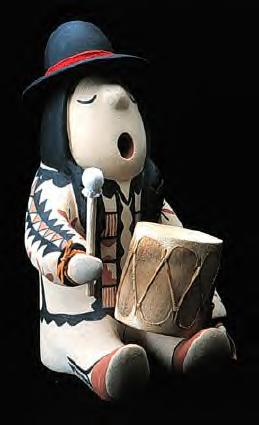|
|
Canku Ota |
|
|
(Many Paths) |
||
|
An Online Newsletter Celebrating Native America |
||
|
april 7, 2001 - Issue 33 |
||
|
|
||
|
Aqua Caliente Storyteller Casts Spell on Audience with Account |
||
|
by Benjamin Spillman The Desert Sun |
||
|
Grandfather Cochiti Storyteller |
 Thousands
of years after his ancestors came to the Coachella Valley, Ray Patencio still tells their story to everyone who
will listen. Thousands
of years after his ancestors came to the Coachella Valley, Ray Patencio still tells their story to everyone who
will listen.Patencio, the son of the last ceremonial bird singer of the Agua Caliente Band of Cahuilla Indians, holds listeners with a style that is part college professor, part American Indian expert and part stand-up comedian. During a recent lecture at the Spa Hotel, he captivated an audience of tourists, snowbirds and tribal members with a talk that included the Cahuilla creation story, tribal politics, American Indian humor and classic westerns. "Indians didnít really exist until 1492, we were just people," Patencio told the audience. "Now theyíve changed our name to Native Americans. Cowboys and Native Americans, it just doesnít have the same ring to it." Jokes aside, Patencio was serious when he explained how stories as old as the Cahuilla culture are still relevant today. Creation: According to one story, human creation occurred here at the beginning of time. Two embryos formed out of the twisting of red, blue, white and brown light. "They grew, they began to talk to one another," Patencio said. They eventually created their own beings. One, Temiawet, was hurried and careless and created beings with too many eyes, paws for hands and two stomachs. The other, Mukat, was more careful and created humans as they appear today. After a battle, Temiawet and his beings disappeared, leaving Mukat with his creations. But there was confusion because Mukatís people spoke all the languages of the earth, Patencio said. Mukat singled out one voice that was strong and reasoned and recognized it as Cahuilla. He made the speaker the first Cahuilla, Patencio said. "That is why Cahuilla speak the original language," he said. More than explaining creation, the stories give insight into the storytellersí culture. "The old ways are just not carried out anymore," Patencio said. "That is not much different than any other cultures." Sean Milanovich, a member of the Agua Caliente tribe, said that by telling stories Patencio contributes to the growth of the Cahuilla culture. "All I see and read, at least in the papers, is that the Indians have a casino. They donít know the culture," Milanovich said. Raising the profile of the Cahuilla culture is especially important now because the tribe is in the early stages of planning for a new museum. New facilities: By 2005, organizers hope to move the Agua Caliente Cultural Museum from its 1,500-square-foot home in downtown Palm Springs. They plan to move into an 80,000-square-foot, $30 million building near the entrance to the Indian Canyons, said Michael Hammond, the museumís executive director. "It is absolutely critical," said Hammond on why it is important to have tribal members willing to talk with the public about American Indian culture. "Otherwise, all you have is people who go out there and get their knowledge from books." |
|
Agua Caliente Band of Cahuilla Indians |
|
|
||
|
|
||
| Canku Ota is a free Newsletter celebrating Native America, its traditions and accomplishments . We do not provide subscriber or visitor names to anyone. Some articles presented in Canku Ota may contain copyright material. We have received appropriate permissions for republishing any articles. Material appearing here is distributed without profit or monetary gain to those who have expressed an interest. This is in accordance with Title 17 U.S.C. section 107. | ||
|
Canku Ota is a copyright © 2000, 2001 of Vicki Lockard and Paul Barry. |
||
|
|
|
|
|
The "Canku Ota - A Newsletter Celebrating Native America" web site and its design is the |
||
|
Copyright © 1999, 2000, 2001 of Paul C. Barry. |
||
|
All Rights Reserved. |
